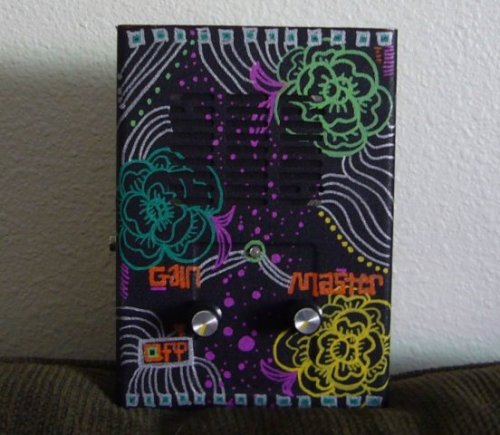Op Amp Guitar Amplifier
Rock This
This is a quick tutorial about making a practice amp for a
guitar. Very quick. And dirty. In fact, it sounds remarkably dirty. The amp is
made from some junk I found in my basement, along with two op amp break out boards from (you guessed it) SparkFun Electronics.
Ten Bucks and Some Junk
I started with the op amp boards, figuring I?d use one for a
gain section and one for a master volume. Getting those was a breeze: just
snatch them off the shelves when no one?s looking. Then I had to go hunting for
something to play it through. If you're like me, you've got many boxes full of
junk stashed in the corners of your living space. Some info for the unmarried
guys, spouses look dubiously upon these hidden treasures. But we know that
they're there for just such opportunities. In one of mine, I found an old GE CB radio. A solid piece of gear as its case was all metal. Splitting the case got
me an 8 ohm speaker and something on which to mount all the junk, along with a
couple of nice pots for power/gain and master settings.
The basic electronics are ridiculously simple (given the
sweet, sweet outcome). Just plug 2 op amp breakout boards together in series,
stick a guitar at one end and a speaker at the other. Check out the schematic here: GuitarAmp.pdf
OK, a very small amount of extra thought went into it. The op amp breakout boards are AC coupled on their inputs (necessary since I'm not running with a bipolar supply), but not on the outputs. So I did have to add one cap, a 100uF electrolytic to couple to the speaker.
The mounting logistics are just about as simple:
Following the first sound tests, I added the pots from the CB (first yanking out the original pots on the op amp boards), mounted a 6Ahr lipo, and gave it a blue LED for a power indicator:
Followed by more testing with our own Pete Lewis...
That's Choppy on the couch with Pete. I don't think he was all that impressed. And if you're interested, the guitar is a Music Man Silhouette Special.
Making It Pretty
Lastly, we added the cool graphics ? la Lara Boudreaux (our resident Graphic Designer):
The final result is one-of-a-kind looks with one-of-a-kind
sound. Does it sound amazing? Well, that depends how you define the term.
Honestly, I haven?t even bothered to put it on a scope to see what the waveform
is doing, but I promise you that it?s deep in saturation when it's cranked. With the knobs all
the way up to 11, it makes some truly profound noises. Turn it down and it's a pretty decent clean channel.
My regular amp is a Fender Blues Jr. With my little cheapo as a preamp, I expect some interesting results. Rock on, my brothers.
Pete Dokter




It's got some good sound and looks quiet simple to make. Perfect, as my amp is very heavy. I think It's an excellent idea.
That's a nice project. I'm such a lousy guitar player that I could never justify buying one of those $500+ amps, but as a $10 project, I may just have to do this.
Thanks for this short tutorial. One question, why does the positive side of the battery go through the gain section potentiometer? <edit>Power on/off.</edit>
Maybe an acoustic amp too? Looks like it could be. Sounds decent and it's very portable. Good choice on the Fender btw.
I love fender amplifiers and I love yours too!
,
Probably the output impedance of the opamp doesnt match the speakers...
Didn't that cause any trouble? why?
Thanks!
All of the pics and PDF links are "forbidden." If you could correct this, it would be awesome. Thanks!
I won't comment on the lack of EQ or tone shaping, except to note that guitar amps are RADICALLY non-flat in frequency response.
And most guitar pickups need a higher input impedance than your 10K to avoid tone loss. The usual "standard" for guitar amps is 1M ohm.